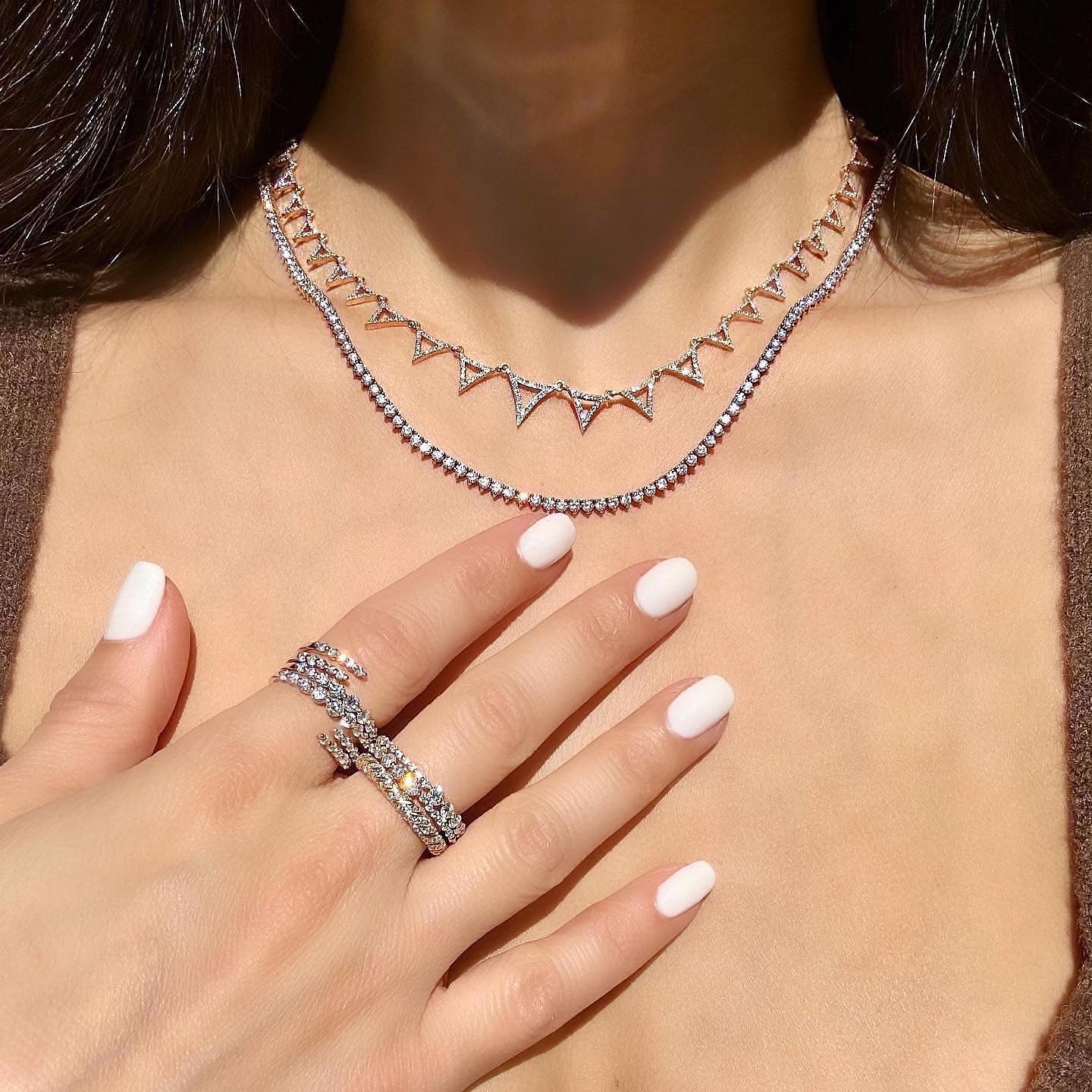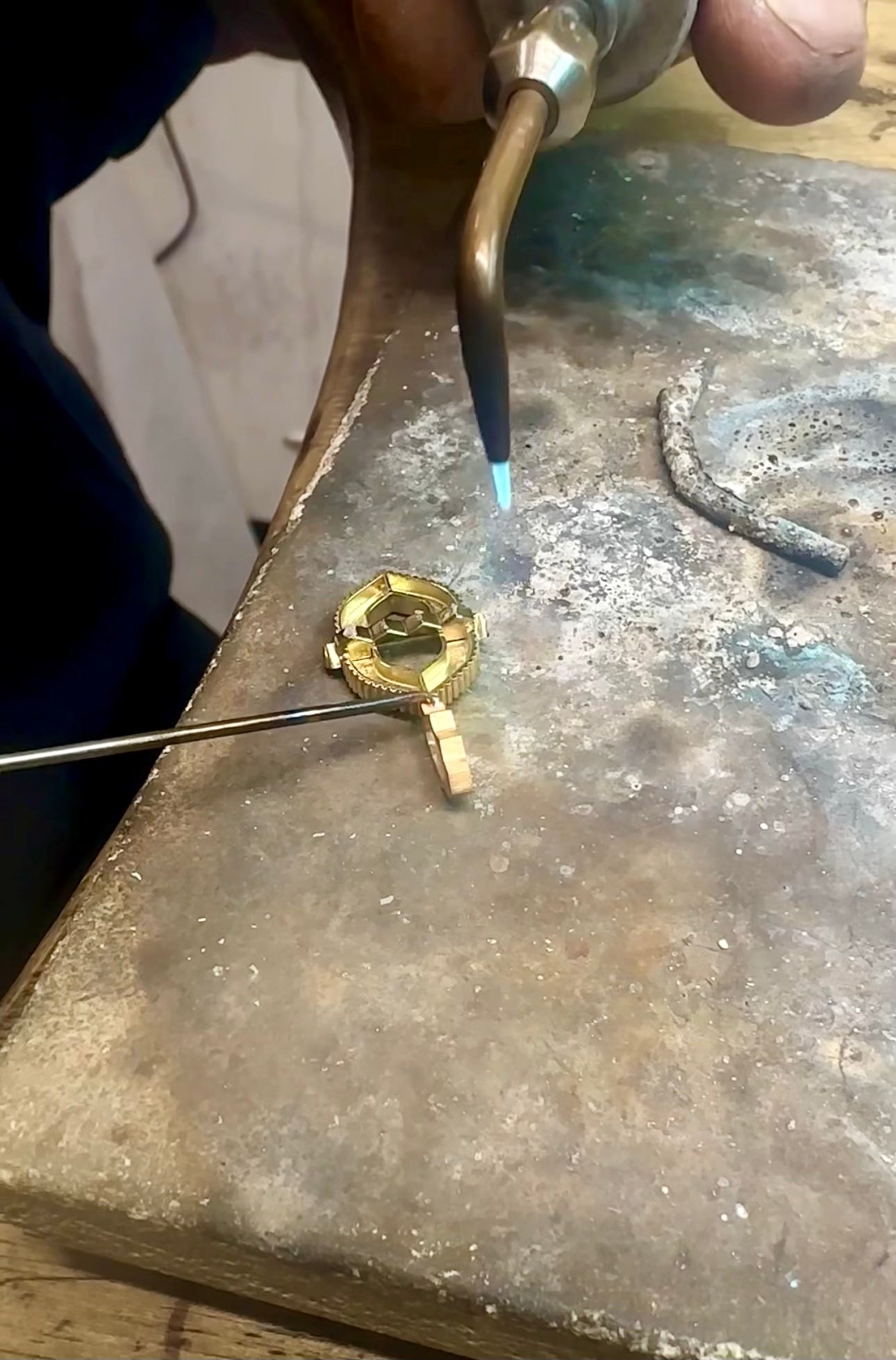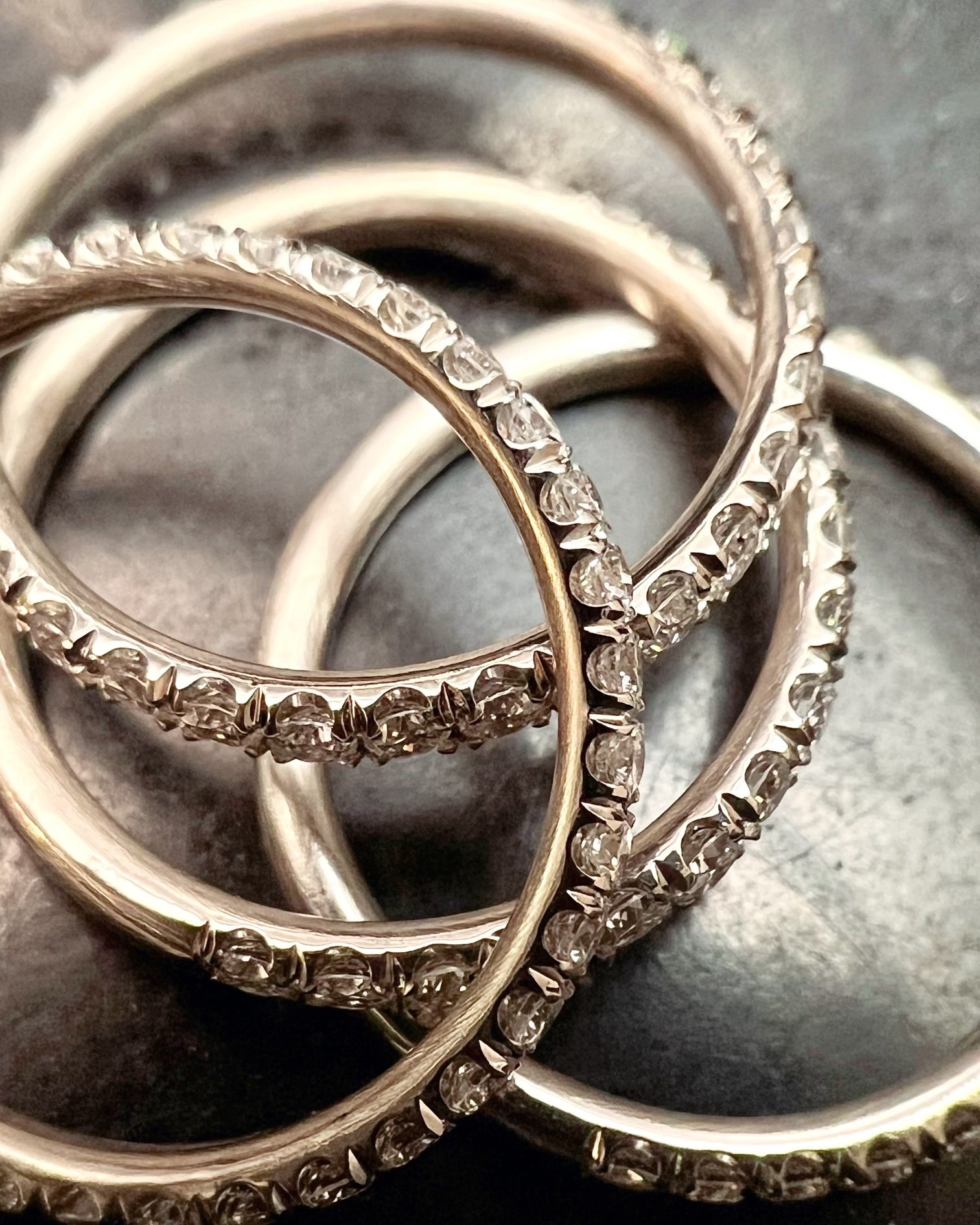Decoding Brilliance: Understanding the 4 C's of Diamonds

In the enchanting realm of diamonds, their beauty is not just skin deep. Delving into the world of these precious gems unveils a fascinating language – the language of the 4 C's. The 4 C's of a diamond—cut, color, clarity, and carat weight—were established by the Gemological Institute of America (GIA) to provide a standardized way of assessing and communicating the quality of diamonds. This system was introduced in the mid-20th century to help consumers make informed decisions when purchasing diamonds.
As you embark on the journey of choosing the perfect diamond, consider the harmonious interplay of these four elements. The 4 C's are not just technical aspects; they are the poetry that defines a diamond's character and allure. Whether you're drawn to the timeless brilliance of a classic cut or the individuality of a unique color, understanding the 4 C's empowers you to select a diamond that resonates with your heart and reflects the brilliance of your unique love story. Let's unravel the mysteries of Cut, Color, Clarity, and Carat Weight, the four pillars that define the brilliance of a diamond.
I) Cut: Crafting the Dance of Light
While all four C's—cut, color, clarity, and carat weight—contribute to a diamond's overall beauty and value, many experts consider cut to be the most important. The cut significantly influences a diamond's brilliance, sparkle, and overall visual appeal.The cut of a diamond is akin to its personality. It determines how light interacts with the stone, reflecting and refracting in a mesmerizing dance. A well-cut diamond allows light to travel through it, creating that coveted sparkle. Whether it's the classic brilliance of a Round Brilliant or the unique allure of a Princess Cut, the precision of the cut is paramount in showcasing the diamond's inherent radiance.
Here's why cut is often considered crucial:
- Brilliance and Sparkle: A well-cut diamond reflects light internally, creating brilliance and sparkle. The precision in cutting determines how effectively light interacts with the diamond.
- Beauty Enhancement: Even if a diamond has high color or clarity grades, a poor cut can result in a lackluster appearance. A well-cut diamond enhances the inherent beauty of the stone.
- Masking Imperfections: A good cut can sometimes mask or minimize the visibility of certain clarity characteristics, making the diamond more visually appealing.
- Subjective Impact: Cut has a direct impact on the observer's perception of a diamond's beauty. A well-cut diamond tends to capture attention and appear more vibrant.
Types of Diamond Cuts
Diamond cut grading involves assessing how well a diamond's facets interact with light. The GIA uses a grading system for cut quality. The cut grade considers factors like proportions, symmetry, and polish.
Proportions refers to the angles and relative measurements of a diamond. Well-proportioned diamonds optimize light reflection. Symmetry involves the alignment and balance of facets. Precise symmetry enhances sparkle. Polish evaluates the smoothness of the diamond's surface. A high polish grade ensured light enters and exists the diamond unimpeded. Here are the key components:
- Ideal Cut: Diamonds with an ideal cut are highly valued for their exceptional brilliance and sparkle. They are cut to perfect proportions for refracting light. An ideal cut often has a table percentage (table size relative to the diameter of the diamond) within a certain range. The depth (height of the diamond) has a percentage that is considered optimal for light refraction. Lastly, the crown and pavilion angle affect how light enters and exits the diamond. Ideal cut diamonds have specific angles for the crown (top part) and pavilion (bottom part).
- Excellent Cut: Diamond reflects nearly all light, creating exceptional brilliance. There is even distribution of light throughout the diamond.
- Very Good: Diamond is considered symmetrical and reflects most light that enters, resulting in high brilliance. There is slightly less optimal light distribution than excellent cut.
- Good: Diamond has a reasonable level of polish and symmetry. It has adequate brilliance with most of the light reflecting. It's more affordable than higher-cut grades.
- Fair: The diamond allows some light leakage, impacting brilliance. It is budget-friendly but with visible compromises in sparkle. They are not always symmetrical.
- Poor: With significant light leakage, diamond appears dim and asymmetrical with uneven spots on surface. It is generally not recommended due to the compromised quality.

Round and Fancy Shape Diamond Cuts
The term "ideal cut" is associated with round brilliant diamonds because the concept of an ideal cut was initially developed for this specific diamond shape. The proportions, angles, and facet arrangement optimized in an ideal cut are designed to maximize the brilliance and sparkle in a round diamond. The round brilliant cut is unique in its arrangement of 57 or 58 facets, including the table, crown, girdle, and pavilion facets.
For other fancy shapes like princess, emerald, marquise, and others, the ideal cut parameters vary because these shapes have different facet arrangements and geometric characteristics. Each fancy shape has its own set of criteria for achieving an optimal balance of brilliance, fire, and scintillation. They can still attain excellent cuts.
While cut is considered highly important, the ideal balance among all four C's depends on individual preferences and the specific qualities a buyer values in a diamond.
II) Color: From Ice to Fire
Diamonds come in a spectrum of colors, from the purest ice-white to warmer hues. The Gemological Institute of America (GIA) grades diamonds on a scale from D (colorless) to Z (light yellow or brown). The less color a diamond exhibits, the higher its grade and value. Color preferences are subjective, but understanding this scale allows you to choose the hue that resonates with your personal taste.

The Diamond Color Scale
The GIA uses a letter scale from D (colorless) to Z (light yellow or brown) to grade diamond color. D, E, and F are considered colorless; as you move down the scale, the presence of color increases.
- Colorless to Near Colorless (D-F): Highly valued for their rarity and lack of noticeable color, these are ideal for settings where the color of the diamond is a crucial factor.
- Near Colorless (G-J): Its minimal color is visible to the naked eye, especially in well-cut diamonds. This makes them generally less expensive than colorless diamonds.
- Faint to Light Color (K-M): Some color is noticeable, particularly in larger diamonds or those with less optimal cuts. These can offer good value, especially if the setting complements the diamond's color.
- Very Light to Light Color (N-R): There is a noticeable color tint, even to the untrained eye. These diamonds are typically not recommended for engagement rings. They may be suitable for other jewelry styles.
- Light to Fancy color (S-Z): These exhibit noticeable color and is considered a fancy color diamond. They can be attractive for those seeking a unique and vibrant look.
Color preferences can vary; some may prefer the icy brilliance of colorless diamonds while others appreciate the warmth of diamonds with a hint of color. The choice of setting and metal can impact how noticeable the diamond's color is.
How to Set Diamonds According to their Color
Setting diamonds according to their color involves considering the diamond's color grade and choosing a setting and metal that complement or enhance the diamond's appearance. Here are some guidelines:
- Colorless Diamonds (D-F): Opt for settings in white metals like platinum or white gold. These metals enhance the diamond's colorless appearance, allowing it to shine without interference.
- Near Colorless Diamonds (G-J): White gold or platinum settings work well for a clean and classic look. Yellow gold settings can complement the slight warmth in these diamonds, providing a warmer and more traditional feel.
- Faint to Light Color Diamonds (K-M): Yellow gold settings can enhance the warmth of these diamonds. Consider settings with intricate designs or halo settings to draw attention away from the diamond's color.
- Very Light to Light Color Diamonds (N-R): Choose settings that mask or distract from the diamond's color, such as those with intricate details or side stones. Yellow gold or rose gold settings can complement the diamond's warmer tones.
- Light to Fancy Color Diamonds (S-Z): Embrace the unique color of the diamond and consider settings that enhance its vibrancy. Yellow gold or rose gold can complement and enhance the diamond's color.
Consider the metal used for prongs and other details in the setting. Opt for metals that either match the main setting or add a contrasting touch for visual interest. Consider settings that incorporate multiple metals for a unique and modern look. This can provide a contrast between the diamond and the setting.
Remember that there are no strict rules, and individual taste plays a crucial role in choosing the right setting for a diamond. It's essential to assess how the diamond looks in different metals and settings to find the combination that appeals to your aesthetic preferences. Some may prefer a classic and timeless look, while others may seek a more contemporary or eclectic style.
III) Clarity: Nature's Imprint
Every diamond bears the unique marks of its journey through the Earth. Clarity refers to the presence of these imperfections, known as inclusions and blemishes. The GIA grades diamonds from Flawless (no imperfections visible under 10x magnification) to Included (imperfections visible to the naked eye). The choice of clarity depends on your preference for a flawless gem or one with character, each telling a story of the diamond's formation.
The Gemological Institute of America (GIA) uses the following clarity grades:
- Flawless (FL): No internal or external flaws visible under 10x magnification. These are extremely rare and highly valued.
- Internally Flawless (IF): No internal flaws visible under 10x magnification. They may have minor external blemishes.
- Very, Very Slightly Included (VVS1 and VVS2): Inclusions are difficult to detect even under 10x magnification. VVS1 has slightly fewer and smaller inclusions than VVS2.
- Very Slightly Included (VS1 and VS2): Inclusions are visible under 10x magnification but are minor. VS1 has fewer and smaller inclusions than VS2.
- Slightly Included (SI1 and SI2): Inclusions are visible under 10x magnification. SI1 has noticeable inclusions but may be concealed by the setting. SI2 has more visible inclusions that may affect brilliance.
- Included (I1, I2, and I3): Inclusions are visible to the naked eye in I1 and more obvious in I2 and I3. Generally, diamonds in this range are not considered high quality. I3 diamonds have inclusions that may affect the durability of the stone.
When choosing a diamond, consider your budget, the size of the diamond, and personal preferences regarding the visibility of inclusions. Keep in mind that diamonds with higher clarity grades are more rare and consequently, more expensive. The choice of clarity grade often involves finding a balance between budget and the desired level of visual purity.
IV) Carat Weight: Beyond Size, a Measure of Rarity
Carat weight measures a diamond's size, but it's more than a matter of sheer scale. Larger diamonds are rarer, making them more valuable. However, the brilliance of a diamond is not solely determined by its carat weight. A well-cut, smaller diamond can outshine a larger one with a lower cut grade. Balancing carat weight with cut is crucial to finding the perfect balance between size and sparkle.

Carat weight significantly affects a diamond's price. Larger diamonds are generally more valuable, assuming similar qualities in cut, color, and clarity. The carat is a metric unit of mass equal to 200 milligrams or 0.2 grams. Each carat is divided into 100 points, providing a precise way to measure and describe a diamond's weight. Diamonds are commonly measured in carats and weights are often rounded to two decimal places. For example, a diamond weighing 0.25 carats may be referred to as a "twenty-five pointer".
Carat and Diamond Size
Remember, carat weight does not solely determine the size of a diamond. Other factors, such as cut and shape, also influence how large a diamond appears. Diamonds with the same carat weight may appear different in size due to variations in cut, shape, and proportions.
Diamonds with shallow cuts have a larger surface area facing upward. This can make them appear larger compared to diamonds with the same carat weight but deeper cuts.
Diamonds with good spread can appear larger because more of their mass is visible from the top. The term "spread" refers to how a diamond's weight is distributed across its surface.
It's important to note that while carat weight is a numerical measure, individual preferences and budget considerations play a significant role in determining the ideal carat weight for a diamond. Some may prioritize size, while others may prioritize the overall quality and brilliance of the diamond.

ABOUT US
OUR MISSION
To redefine fine jewelry by creating exclusive designs that celebrate individuality and craftsmanship, all without the traditional retail markups, providing true value directly to our customers.
Fine Jewelry with a Refined Sense of Noblility
Vardui Kara is a fine jewelry collection founded on the principles of exploring new and experimental concepts, while collaborating with the most skillful artisans in Los Angeles to create timeless pieces with collector's appeal. The line incorporates multi processes of design and stone setting to intrigue the women who believe everyday jewelry does not need to be basic.
Jewelry holds a personal meaning to us all and that is why we have set out to create something authentic and modern that helps a woman tell her story. Unique details and a balanced design come together to encourage a refined self-expression.
Why We Are Different
Exclusive Collections
We believe in the rarity of true beauty. That's why we offer limited edition collections and exclusive designs that are not widely available. Our jewelry is meant to feel personal and precious, giving you something truly special that you won't see on everyone else.
Our Commitments
Exceptional Customer Experience:
At the heart of our brand is our commitment to providing an extraordinary customer experience. From your first inquiry to the moment you wear your new piece, we are with you every step of the way. We believe in building lasting relationships with our clients, ensuring every interaction is personal and memorable.
We Have Said Bye To:
Wholesale distribution markups, excess assortment, production markups, import costs, retail markups, and sales commissions.Unlike the traditional jewelry industry, we set out to launch our own model to design, create, source, and sell fine jewelry directly to you. Instead, we focus on thoughtful product assortment, responsible production, quality materials made to last a lifetime, working with local manufacturers, and handling the shipping ourselves.
To put it simply, our jewelry is handcrafted with the same high quality materials and craftsmanship as other luxury jewelry brands without the traditional markups.

Our Jewelers
We spent two full years searching Los Angeles to find the best master jewelers for our various collections. Some of the jewelers we work with are third-generation craftspeople. All of them are committed to excellent and intricate craftsmanship on producing quality pieces. We value each artisan for their unique skills such as soldering, stone setting, or sandblasting. By making each jewelry item to order, we support local and talented artisans while, at the same time refusing the purposeless wastage often seen from mass productions.

Meet our Designer
Growing up in Downtown Los Angeles' Jewelry District as the daughter of a precious metals dealer, Vardui Karaoglanyan was influenced by the creative freedom and expertise around her. After earning a degree in Economics and Finance, she trained under sculptural jewelry designers, developing her own style that blends modern minimalism with bold architectural influences. Her designs are inspired by Renaissance themes and feminine strength, featuring 14 and 18 karat recycled golds, and ethically-sourced diamonds. Each piece is crafted to make a powerful statement, with a balance of elegance and daring edginess, perfect for layering and mixing.
Vardui Kara aims to offer exclusive designs to create a collector's mentality, all without the traditional retail markups, making luxury more accessible.
Personalization
One-Of-A-Kind Options
Your style is uniquely yours, and your jewelry should reflect that. That is why we offer customization options that allow you to create one-of-a-kind pieces, tailored to your taste and vision. Whether it’s a personalized engraving or a custom design, we’re here to bring your ideas to life.

Our Materials & Ethics
Our collections are handmade in Los Angeles and created from rich 14-karat and 18-karat golds, sterling silver, and full-cut diamonds. We make it a priority to work with local, reputable suppliers who share our values of ethical and conscious production. We use recycled precious metal and our diamonds are sourced from trusted partners who guarantee their product to be conflict-free. We inspect every single stone and ounce of gold to be certain it meets your highest standards and exceeds your highest expectations. Our jewelry is designed to last.
